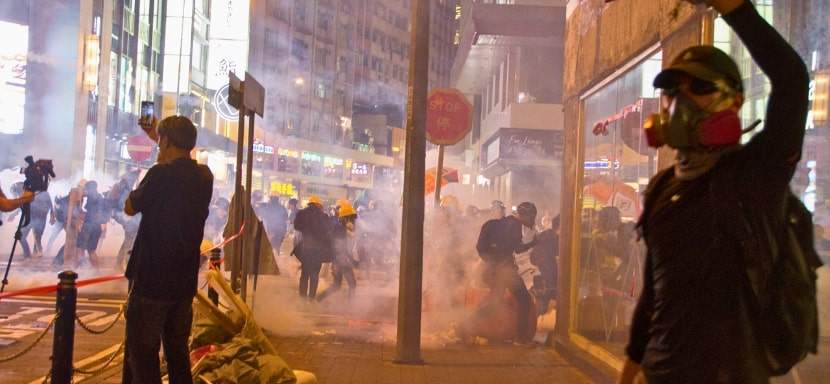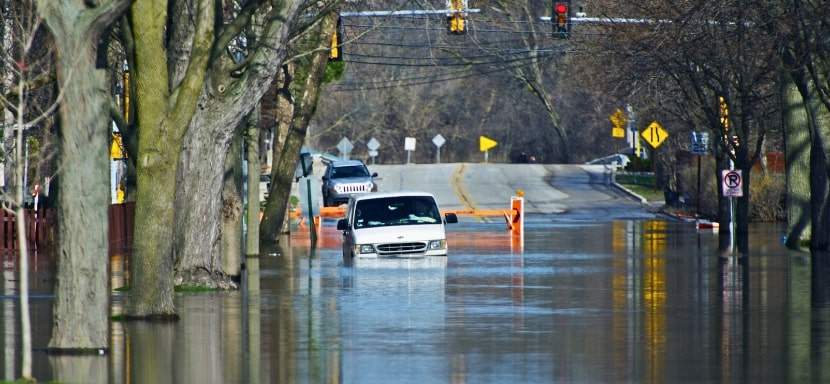How to Survive a Riot

Riot Survival Tips and Strategies
Riots in the United States often stem from social, political, or economic unrest, leading to public demonstrations that can escalate into widespread violence and chaos. These events typically reflect underlying societal tensions and can provoke significant national discourse on justice, equity, and law enforcement practices.
Surviving a riot involves more than just reacting spontaneously. It requires foresight, calmness, and a well-thought-out plan. In today’s uncertain times, urban disturbances are increasingly common, making it crucial to know how to navigate and survive these harrowing events.
This survival guide offers detailed strategies for staying safe if caught in a riot.
Key Points
- Riot Dynamics: Understand the causes and signs to prepare and respond effectively.
- Survival Strategies: Avoid confrontations and navigate safely through chaos.
- Post-Riot Recovery: Engage in recovery efforts and understand legal rights.
What is a Riot?
A riot is a violent disturbance of the peace by a crowd, involving disruptive behavior in public spaces, often leading to property damage and physical violence. Typically, a riot arises from political, social, or economic grievances expressing chaotic and uncontrolled protest against perceived injustices or authority.
Understanding the Dynamics of a Riot
Understanding the dynamics of a riot is crucial for enhancing your preparedness and response. Here is an expanded discussion of the factors that influence riot behaviors and how you can anticipate and react appropriately:
The Social and Psychological Underpinnings
- Origin of Grievances: Riots typically arise from deep-seated social unrest, unresolved political grievances, or escalated mass protests. These can range from racial injustice and economic inequality to political corruption and government actions.
- Crowd Psychology: During riots, the collective behavior of the crowd can exert a powerful influence over individual actions. People may participate in activities they would typically avoid, driven by the anonymity and diffusion of responsibility within the crowd. This phenomenon, known as “deindividuation,” makes understanding crowd psychology vital.
- Emotional Contagion: Emotions can spread rapidly among crowd members, escalating the situation. Fear, anger, and frustration are infectious and can turn a peaceful assembly into a violent riot.
Common Triggers and Signs
- Economic Factors: Economic downturns often heighten the likelihood of riots, as financial hardship and job insecurity can fuel public discontent.
- Controversial Events: Decisions or events perceived as unjust, such as controversial judicial verdicts or incidents of police brutality, can ignite immediate public outrage and lead to riots.
- Political Instability: In regions or times of political turmoil, where trust in government and institutions is low, the populace may resort to riots as a form of protest or to voice their displeasure.
Step-by-Step Guide if Caught in a Riot
If you find yourself unexpectedly caught in a riot, taking the proper steps can help you escape safely. Here is a step-by-step guide to navigating through such a chaotic situation:
- Stay Calm: Prioritize keeping your cool despite the chaos. Panicking can cloud your judgment and reduce your ability to make safe decisions.
- Avoid Drawing Attention: Blend into the surroundings as much as possible. Avoid standing out by staying quiet and moving with the flow of the crowd until you can find an escape route.
- Locate a Safe Exit: Identify the nearest exits from the area, but avoid moving against the crowd to reach them. Look for side streets or less congested pathways.
- Move Sideways to the Crowd: Gradually reach the crowd’s edge. It’s usually safer, and you’ll have more control over your movement than in the center.
- Seek a Temporary Shelter: If an escape route isn’t immediately accessible, find a safe place to take temporary shelter. This could be inside a sturdy building or a less affected area nearby.
- Communicate with Loved Ones: Inform someone of your situation and location if it’s safe. Use your phone to send a quick message or make a call.
- Avoid Confrontations: Avoid aggressive interactions and confrontations. Do not engage aggressively with rioters or law enforcement.
- Use Landmarks to Navigate: Familiarize yourself with landmarks in the area that can guide you to safety. These can be large buildings, parks, or other notable spots.
- Follow Local Authorities’ Instructions: Pay attention to any instructions or directions given by local authorities. Local authorities often communicate instructions via loudspeakers, police lines, social media, and regional broadcasts.
- Keep Your Identification Handy: Have your identification ready in case you need to show it to authorities to pass through controlled areas.
- Stay Informed: Use your smartphone or radio to keep updated on the situation as it develops. Information about safe zones, curfews, and road closures can be crucial.
- Exit the Area Safely: Moving away from the riot zone as quickly and safely as possible once you find a viable exit route. Continue to stay alert until you reach a safe location.
Following these steps can increase your chances of safely exiting a riot. Always prioritize your safety and the safety of those with you above all else.
Did You Know?
During the 1960s, the United States experienced a wave of riots, notably the long, hot summer of 1967, when more than 150 riots occurred across various cities—this period highlighted the extensive racial tensions and dissatisfaction with social inequalities that had been simmering beneath the surface of American society.
Recognizing Early Warning Signs
Awareness of the potential for riots involves monitoring various indicators suggesting rising tensions. These include:
- Increased Local Activism: A sudden spike in demonstrations, protests, or community organizing can be a precursor to more significant disturbances.
- Security Preparations: Heightened security measures, such as increasing police presence or issuing emergency declarations, often indicate anticipated problems.
- Public Sentiment: Changes in public sentiment, gauged through social media, news outlets, and public forums, often provide early signals of growing unrest.
Proactive Measures
Taking proactive measures based on the understanding of these dynamics includes:
- Community Engagement: Participating in community dialogues can help address grievances before they escalate.
- Personal Preparedness: Developing a personal safety plan, including knowing when to avoid certain areas and how to escape if caught in a riot, enhances individual security.
- Staying Informed: Keeping up-to-date with local news and community alerts helps you stay one step ahead of developments that could lead to violence.
Preparing Before a Riot
Proper preparation can significantly improve your ability to stay safe during a riot.
Here’s how you can prepare:
Assembling an Emergency Kit
- Essentials: Your kit should include a few days’ water supply and non-perishable food items. Choose easy-to-prepare and consume foods, such as canned goods, energy bars, and dried fruits.
- First Aid Supplies: Pack a comprehensive first aid kit that includes items like bandages, antiseptic wipes, adhesive tape, pain relievers, and any prescribed medications that you or your family members might need.
- Personal Documents: Include copies of important documents such as ID cards, insurance policies, and bank account records, sealed in a waterproof container.
- Utility Tools: Equip your kit with a flashlight, extra batteries, a multi-tool, and a manual can opener. These tools can be invaluable in a power outage or if you need to make quick repairs.
- Communication Devices: A battery-powered or hand-crank radio can keep you connected to the outside world when cellular networks are down. Consider including a charged power bank to keep your mobile devices powered.
Staying Informed
- Local News: Regularly check local news channels and newspapers for updates on demonstrations or unrest that could escalate into riots.
- Social Media and Apps: Follow relevant hashtags and accounts on social media platforms for real-time updates. Apps aggregating safety alerts based on location can also provide timely information.
- Community Networks: Engage with community networks or neighborhood groups that share safety updates. These groups can be great resources for localized information.
- Government Alerts: Register for government emergency notification systems that can send instant alerts to your phone or email, informing you of curfews, road closures, and other critical news.
Home Safety Precautions
- Secure Your Property: Enhance the security of your home by reinforcing doors, securing windows, and considering the installation of security cameras or alarm systems.
- Escape Plan: Familiarize yourself with all possible exits from your home and neighborhood. Having a clear escape plan can make a significant difference in an emergency.
- Safe Room: Designate a safe room where you can retreat if riots escalate and reaching an exit is unsafe. This room should be easily secured and preferably have access to water and sanitation facilities.
How to Stay Safe During a Riot
Surviving a riot involves proactive avoidance and preparedness strategies. Here are detailed guidelines for finding safety and protecting yourself during such turbulent events.
Finding Safety
The primary goal during a riot is to avoid getting caught in the chaos. Here’s how you can ensure your safety:
Avoiding Confrontation:
- Stay Indoors: The safest place during a riot is inside a secure building. Stay away from windows and doors and move to the innermost parts of your home or a designated safe room.
- Business Safety: Keep the premises locked if you own or operate a business. Consider installing shutters or reinforced glass and have an evacuation plan for employees.
Escape Routes:
- Plan Multiple Exits: Know the layout of your neighborhood and plan several paths to safety. Consider less apparent routes that might be less crowded.
- Vehicle Readiness: If you rely on a vehicle, keep it fueled and ready. Park it in a garage or secured area, facing an exit route for a quick departure.
- Public Transport: Be aware of the public transport options available and their operational status during emergencies.
Protecting Yourself
If escape isn’t possible immediately, knowing how to protect yourself becomes essential.
Self-Defense:
- Basic Techniques: Familiarize yourself with fundamental self-defense moves that can prevent harm. Avoid aggressive behavior that might escalate the situation.
- Legal Weapons: Consider carrying non-lethal self-defense tools, such as pepper spray or a stun gun, where legally permissible. Ensure you know how to use these tools effectively and safely.
Improvised Protective Gear:
- Body Protection: Use items like thick jackets, backpacks, or padded clothing to protect against impacts from debris or non-lethal projectiles.
- Headgear: Helmets or even sturdy hats can offer vital protection. DIY padding added to the inside can increase their effectiveness.
- Eye Protection: Goggles can protect your eyes from tear gas, smoke, and flying objects. Ensure they fit well and provide adequate coverage.
By employing these strategies, you can enhance your chances of staying safe during a riot. Avoiding confrontation and understanding escape routes will help you navigate away from danger while knowing self-defense and using improvised protective gear can shield you from harm if escape is not an immediate option. These methods are not just about physical safety; they also aim to reduce anxiety and fear, providing mental clarity in crises.
Navigating Through a Riot
Navigating through a riot safely is a challenging ordeal that demands courage, calm, and strategic thinking.
Staying Invisible
- Low Profile: Your goal is to avoid drawing attention. Act as if you blend in with the surroundings and avoid any actions that could single you out.
- Non-Provocative Clothing: Wear clothes that do not stand out in the crowd; avoid logos, slogans, or bright colors that might be associated with any side of the conflict. Opt for neutral, dark colors that are less noticeable.
- Protective Gear: Beyond just non-provocative, your clothing should protect you. Thick layers can shield against minor impacts, such as from thrown objects.
- Calm Movement: Even if you find yourself panicking internally, exhibit calmness. Quick, sudden movements can attract unwanted attention. Move deliberately towards an identified exit, using covered paths if possible.
Following the Flow
- Moving with the Crowd: There may be situations where pushing against the crowd could be more dangerous and make you a target of violence. In such cases, it’s safer to move with the crowd.
- Please stay on the Edges: While moving with the crowd is safer, staying on the edges allows an easier escape. You can more quickly slip out to a side street or alley away from the main body of the crowd.
- Recognize Escape Opportunities: Keep looking for potential escape routes as you move. Any opening in buildings, alleyways off the main street, or even less crowded side streets might offer a safer path away from the crowd.
Additional Safety Measures
- Avoid Barricades: Law enforcement may set up barricades to control the crowd’s movement. Please avoid these high-tension areas, as they can become focal points for conflict.
- Watch for Law Enforcement Cues: Keep an eye out for any indications from law enforcement about where to go or areas to avoid. This could be through loudspeakers, hand signals, or other forms of communication.
- Use Landmarks: Familiarize yourself with landmarks beforehand, if possible. Knowing the location of important places like police stations, hospitals, and large public parks can help you orient yourself quickly, even under stress.
Mental Readiness
- Stay Alert: Keep all your senses alert to changes around you. The dynamics of a riot can change quickly, and being perceptive to these changes can mean the difference between getting trapped and escaping.
- Mental Map: Try to maintain a mental map of your surroundings, including identifying potential safe spots and dangerous areas as you move.
- Avoid Confrontation: Do not engage with rioters or law enforcement aggressively. Your objective is to exit the situation as safely and quickly as possible, not to escalate it.
Legal Considerations and Rights
Navigating the legal landscape during a riot is crucial to ensure that you protect your rights while also avoiding unnecessary legal entanglements. Here’s a detailed look at the legal considerations and rights you should be aware of:
Understanding Legal Rights
- Right to Defense: You have the right to defend yourself if someone directly threatens you with harm. However, ensure your self-defense is proportional to the threat and does not escalate the violence.
- Avoiding Violence: Engaging in violent acts, even if defensive, can lead to significant legal consequences. Law enforcement may not distinguish between defensive actions and aggressive participation in the riot.
- Freedom of Assembly: The U.S. Constitution protects your right to peaceful assembly but does not protect violent assembly. Understanding this difference can help you decide when and how to participate in protests.
Detainment and Arrests
- Arrest Procedures: If the police detain you, they must read your rights (Miranda rights), including the right to remain silent and an attorney.
- Right to Legal Representation: If you are arrested, you have the right to consult with an attorney. If you cannot afford one, the court will provide a public defender.
- Search and Seizure: Understand that law enforcement may search your person and belongings at the time of arrest. Knowing your rights regarding search and seizure can guide your interactions with law enforcement.
During Detainment
- Communication: You have the right to make a local phone call after being arrested. Use this to contact a family member, friend, or lawyer.
- Silence is a Right: You have the right to remain silent. Exercise this right until you can speak with an attorney, as anything you say can be used against you in court.
- Bail and Release: If law enforcement holds you, you may qualify for bail. Familiarizing yourself with the typical bail process for riot-related charges in your area can help you prepare financially and logistically.
Long-Term Legal Considerations
- Criminal Record: Participation in a riot can lead to a criminal record, which can impact future employment, travel, and educational opportunities.
- Legal Assistance: Consider consulting with a lawyer specializing in civil rights or criminal defense to discuss any actions you might have taken during a riot and any charges you may face.
- Community Legal Resources: Many communities offer legal aid services that provide free advice and representation for those involved in protests or arrested during riots.
Proactive Legal Preparedness
- Educate Yourself: Before participating in any protest, learn about the legal implications and prepare for scenarios where you might need legal advice.
- Documentation: Keep documentation of any interactions with law enforcement, including names, badge numbers, and the circumstances of the encounter, as these can be crucial in legal defenses.
- Know Your Local Laws: Laws regarding public gatherings, protests, and riots can vary significantly by location. Familiarize yourself with local ordinances to better understand what is legally allowed and what could potentially lead to arrest.
Coping After a Riot
Coping with the aftermath of a riot involves addressing both the psychological impact and the physical damage. It demands resilience and the right resources.
Here’s how you can manage the post-riot challenges:
Seek Professional Help
- Consult a Therapist: If you’re experiencing stress or trauma from the riot, schedule consultations with a mental health professional. They can provide strategies to manage and recover from the psychological impacts.
- Join Support Groups: Participate in community support groups. Sharing experiences and recovery strategies with others who have faced similar situations can be incredibly therapeutic.
Community Recovery
- Engage in Local Efforts: Actively participate in local recovery initiatives. Whether helping clean up debris, repairing damaged properties, or supporting affected neighbors, your involvement can significantly aid in communal healing.
- Promote Community Events: Organize or take part in community-building events. Public meetings, workshops, and communal gatherings can strengthen neighborhood ties and foster a sense of normalcy and security.
- Support Local Businesses: Patronize businesses that the riot has impacted. Supporting local enterprises not only helps in economic recovery but also rebuilds community morale.
Personal and Home Recovery
- Repair and Rebuild: Assess any damage to your property and initiate repairs as soon as possible. This will not only restore your living space but also help you regain a sense of control and normalcy.
- Implement Safety Improvements: Consider upgrading your home’s security to prevent future incidents. This could include more robust doors, better locks, and a comprehensive home security system.
- Reflect and Learn: Reflect on the event and your response to it. Learning from what happened can improve your preparedness for potential future emergencies.
Emotional and Psychological Care
- Routine Restoration: Reestablish your daily routines as soon as possible. Stability in your daily life can significantly enhance emotional recovery.
- Stay Connected: Maintain open lines of communication with friends and family. Emotional support is crucial during stress and recovery.
FAQs About Riots
What are the best strategies for avoiding violence in a riot?
How can I prepare my home if a riot is likely nearby?
What should I do if I get caught in the middle of a riot?
Is it legal to defend myself during a riot?
How can I help my community recover after a riot?
What psychological effects might I experience after surviving a riot?
Navigating the Turmoil: Key Takeaways for Safely Surviving a Riot
Surviving a riot requires understanding its dynamics, preparing in advance, and applying intelligent survival strategies during the event. By staying well-informed about potential triggers and developments, actively avoiding hazardous confrontations, and fully understanding your legal rights, you can navigate these challenging situations more effectively and ensure your safety.
This proactive approach ensures that you are never caught off-guard and always have actionable plans ready to implement. Staying alert to the signs that precede such events, preparing emergency kits and escape routes, and embracing non-confrontational behavior during riots are crucial for your safety. Ultimately, your ability to remain calm, collected, and prepared at all times is what will most effectively protect you from the chaos of a riot.
Major Riots in History: A Chronological Overview
This list explores some of the most significant riots in history, tracing the impact of public unrest from ancient times to the modern era.
Each event highlights the socio-political tensions and conflicts that can lead to widespread violence and change.
- Spartacus Slave Rebellion (73-71 B.C.): The gladiator Spartacus led a major slave uprising against the Roman Republic that threatened the heart of Rome before its suppression.
- Gordon Riots (1780): Anti-Catholic riots erupted in London, primarily driven by opposition to the Papists Act of 1778, which sought to reduce official discrimination against British Catholics.
- Haymarket Riot (1886): A peaceful rally in Chicago, supporting workers striking for an eight-hour day, turned violent when someone threw a bomb at the police.
- Bloody Sunday (1905): Started as a peaceful protest led by Father Gapon in St. Petersburg, Russia, this event turned into a massacre when the Imperial Guard opened fire on the crowd, sparking the Russian Revolution of 1905.
- Watts Riots (1965): A series of violent clashes erupted in Los Angeles, California, as part of the more prominent Civil Rights Movement, ignited by allegations of police brutality against the African American community.
- Detroit Riot (1967): Also known as the 12th Street Riot, it was one of the most violent urban revolts in the 20th century, triggered by a police raid on an unlicensed, after-hours bar.
- Stonewall Riots (1969): A series of spontaneous demonstrations by members of the gay community in response to a police raid that began in the early morning at the Stonewall Inn in Greenwich Village, New York City.
- Los Angeles Riots (1992): Sparked by the acquittal of four LAPD officers filmed beating Rodney King, these riots featured widespread looting, assault, and arson, highlighting deep-seated issues of racial inequality and police brutality.
- 2011 England Riots: Triggered by the police shooting of Mark Duggan in Tottenham, North London, these riots involved looting, arson, and mass deployment of police and highlighted issues of social inequality and racial profiling in the U.K.
- Ferguson Riots (2014): Sparked by the fatal police shooting of Michael Brown in Ferguson, Missouri, these riots highlighted systemic racial disparities in the United States and sparked a national conversation about police practices and racial injustice.
- Ukraine Euromaidan Protests (2013-2014): These started as public demonstrations in Kiev against the government’s decision to suspend the Ukraine-European Union Association Agreement in favor of closer economic relations with Russia and escalated into a full-blown crisis that included days of rioting.
- Baltimore Protests (2015): Following the death of Freddie Gray while in police custody, the city of Baltimore, Maryland, experienced protests and riots against systemic police brutality.
- 2016 Milwaukee Riots: These erupted after the shooting of Sylville Smith by a Milwaukee Police Officer, which sparked two days of public unrest in the predominantly African American neighborhood.
- Yellow Vest Protests (2018-2019): Originating in France, these protests became violent as demonstrators clashed with police over fuel taxes and economic inequality, spreading the movement to other countries.
- Hong Kong Protests (2019): In response to proposed extradition laws, these escalated into broader anti-government clashes marked by significant confrontations between demonstrators and police.
- 2020 United States Racial Justice Protests: Triggered by the murder of George Floyd by a Minneapolis police officer, these widespread protests against racial injustice and police brutality saw instances of rioting and looting alongside peaceful demonstrations.
- Capitol Hill Riot (January 6, 2021): A mob of supporters of then-President Donald Trump stormed the U.S. Capitol building to overturn his defeat in the 2020 presidential election, marking a significant moment of political unrest in American history.
More Crime & Terror Scenarios
How to Survive a Nightclub Shooting
Nightclubs pulse with life—lights flashing, music pounding, bodies packed tight on the dance floor. It’s a place to…
How to Survive Porch Pirates
If there’s one thing worse than a soggy box on your doorstep, it’s an empty spot where a package should…
How to Survive a Swatting Incident
Imagine the doorbell ringing, and instead of the pizza delivery guy, you see flashing lights, uniformed…
How to Survive a Human Trafficking Situation
Surviving a human trafficking situation takes courage, quick thinking, and sometimes a little luck. It’s not a…
How to Survive Being Stalked
Surviving a stalker is like trying to outrun a persistent mosquito in the middle of the night. No matter how…
Recent Survival Posts
How to Survive a Layoff
Layoffs feel personal—even when they’re not. One day, you’re responding to Slack messages and forwarding…
How to Survive a Drug Test
I never imagined I’d be so emotionally invested in a paper cup. But there I was, standing under the fluorescent…
How to Survive an Interrogation
If you’ve ever been caught in the crosshairs of an overly enthusiastic mall cop or stared down by someone…
How to Survive a Nightclub Shooting
Nightclubs pulse with life—lights flashing, music pounding, bodies packed tight on the dance floor. It’s a place to…
How to Survive a Bachelor Party
A bachelor party is a delicate mix of celebration, chaos, and questionable decision-making, wrapped…
More Crime and Terror Survival Scenarios

How to Survive Porch Pirates
If there's one thing worse than a soggy box on your doorstep, it's an empty spot where a package should be. Porch pirates—the modern-day scourge—are bold thieves who swipe packages left unattended. These petty criminals might seem like a minor nuisance compared to...

How to Survive a Swatting Incident
Imagine the doorbell ringing, and instead of the pizza delivery guy, you see flashing lights, uniformed officers, and weapons drawn. It's a scene nobody wants to star in, yet swatting incidents are becoming more common in today's digital age. A prank to some but a...

How to Survive a Human Trafficking Situation
It’s terrifying even to imagine being trapped in a human trafficking situation. These moments can feel hopeless, and it might seem like no one is coming to help. But the truth is, people have escaped and survived these situations. You can, too. Knowing what to do in...

How to Survive Being Stalked
Surviving a stalker is like trying to outrun a persistent mosquito in the middle of the night. No matter how hard you swat, it keeps coming back. But unlike mosquitoes, a stalker is a serious threat that can turn your life upside down. The good news is that you can...

How to Survive Being Drugged
In an increasingly unpredictable world, knowing how to protect yourself from being drugged is essential. This guide provides practical advice on recognizing the signs of being drugged, immediate steps to take, and long-term strategies for safety. With personal...
More Survival Scenarios

How to Survive a Layoff
When the Floor Falls Out: The Reality of a Layoff Layoffs feel personal—even when they're not. One day, you're responding to Slack messages and forwarding emails. Next, you're staring at your monitor as it logs you out... for good. Whether it's a restructuring, a...

How to Survive a Drug Test
The Cup, The Room, The Truth I never imagined I’d be so emotionally invested in a paper cup. But there I was, standing under the fluorescent hum of a strip-mall clinic, trying to recall the last time I ate a poppy seed bagel. That’s the thing about drug tests—they...

How to Survive an Interrogation
If you've ever been caught in the crosshairs of an overly enthusiastic mall cop or stared down by someone in a uniform with a clipboard and a glare, you’ve felt it — the chilly fingers of interrogation anxiety. And while most of us imagine interrogation scenes as...

How to Survive a Nightclub Shooting
Nightclubs pulse with life—lights flashing, music pounding, bodies packed tight on the dance floor. It’s a place to escape, feel the rhythm, and lose yourself in the crowd. But that same energy can turn deadly in seconds, transforming a night of fun into one of the...

How to Survive a Bachelor Party
A bachelor party is a delicate mix of celebration, chaos, and questionable decision-making, wrapped in the noble intention of sending the groom off into married life with a night he’ll (hopefully) remember. It’s a ritual as old as time—well, as old as men deciding...

How to Survive Your First Time at the Gym
Walking into a gym for the first time can feel like stepping into an alien world. The machines hum with purpose, the regulars move confidently, and you’re left standing there, clutching your water bottle, wondering whether you’re in the right place—or on the right...

How to Survive a Worldwide Communications Breakdown
Imagine waking up to silence. Your phone doesn’t buzz, your email won’t load, and even your local radio station crackles with static. A worldwide communications breakdown has hit. What next? For many, this doomsday scenario may sound like the opening lines of a...

How to Survive a Flash Flood While Driving
Surviving a flash flood while driving requires quick thinking, calmness, and a solid plan to ensure your safety. Preparation can make all the difference between a close call and a catastrophe in emergencies like this. This guide provides practical advice to protect...

How to Build an Emergency Kit
Emergencies don’t knock politely at the door. They barge in, uninvited, like a distant relative with a penchant for drama, turning your world upside down without warning. Whether it’s a power outage, a natural disaster, or an unexpected evacuation, the key to staying...

How to Protect Yourself From Insects in the Wild
There’s nothing like being out in the wild—birdsong echoing through the trees, the fresh scent of earth, and a deep sense of peace that makes you think, “Ah, this is what life is about.” But then comes the buzzing. Mosquitoes, ticks, and flies swoop in like uninvited...
